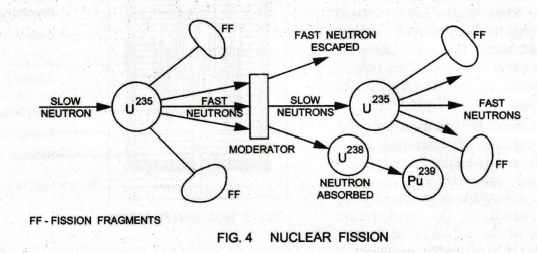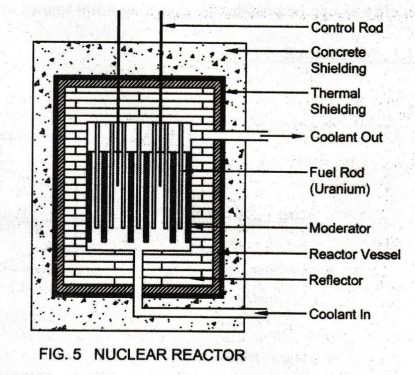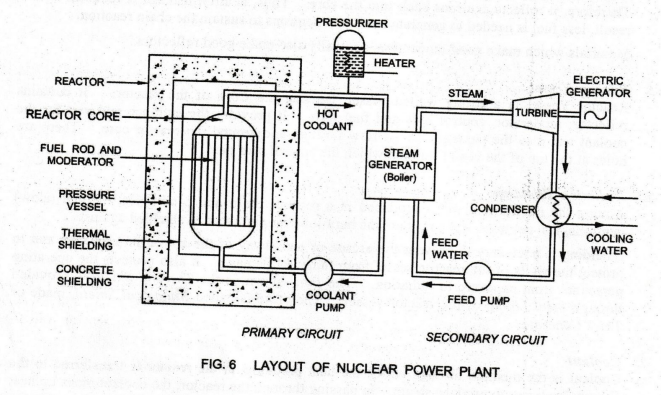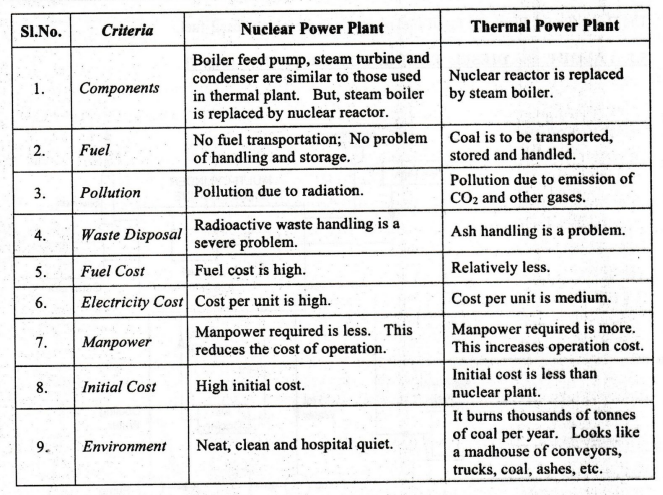Basic Civil & Mechanical Engineering: UNIT IV: a. Power plants
Nuclear power plant
Working Principle, Classification, Layout Diagram, Advantages, Disadvantages, Location
The need of Nuclear Power Plant lies in the fact that the hunger for electricity is virtually unending and unsatisfied, as it is needed to lighten man’s burden and to brighten the world.
NUCLEAR POWER PLANT
The
need of Nuclear Power Plant lies in the fact that the hunger for electricity is
virtually unending and unsatisfied, as it is needed to lighten man’s burden and
to brighten the world.
Working
Principle
A
Nuclear Power Plant differs from a thermal power plant only in the steam
generating part. There is no change in the turbine-generator and the condensing
systems. The nuclear fuel which is at present in commercial use is Uranium.
Scientists say that 1 kg of U235 can produce as much energy as can be produced
by burning 4500 tonnes of high grade coal.
1. NUCLEAR FISSION

Refer
Fig. 4. Uranium exists in the isotopic form of U235 which is unstable. When a
neutron enters the nucleus of U235, the nucleus splits into two
equal fragments and also releases 2 or 3 fast moving neutrons with a velocity
of 1.5 × 107 meters/sec producing a large amount of energy, nearly
200 million electron-volts. This is called Nuclear Fission.
Chain
Reaction
The
neutrons released during the fission can be made to fission other nuclei of
U235 causing a Chain Reaction. A chain reaction produces enormous amount of
heat, which is used to produce steam. [ The chain reaction under uncontrolled
conditions can release extremely large amounts of energy causing Atomic
Explosion.]
Energy
liberated in chain reaction, according to Einstein Law, is E = mv2, where E =
energy liberated, m = mass in grams, v = speed of light = 3 × 1010
cm/sec.
Out
of 2.5 neutrons released in fission of each nuclei of U235, one
neutron is used to sustain the chain reaction, 0.9 neutron is converted into
fissionable material Pu239-and 0.6 neutron is absorbed by Control Rod to
control the rate of reaction inside the reactor.
Function
of the Moderator is to control the neutrons speed inside the reactor. The
moderators used may be liquid (ordinary water and heavy water) or solid
(graphite).
2. NUCLEAR REACTOR
A
Nuclear Reactor may be regarded as a substitute for the Boiler Furnace of a
thermal power plant. Heat is produced in the reactor due to nuclear fission of
the fuel U235.
A
Nuclear Reactor is the heart of the nuclear plant. It is a neutron machine for
starting and controlling a self-sustaining fission chain reaction, that is, to
control the emission and absorption of neutrons. Nuclear reactors are used for
several purposes, viz., to produce heat for power generation, to produce
fissionable materials, etc., to propel sub-marines, aircrafts, etc.
Parts
of Nuclear Reactor (Fig. 5)

1.
Reactor Core and Fuel Rods
Fuel
Rod of a nuclear reactor should be a fissionable material. A Fissionable
Material is an element or isotope whose nuclei can be caused to undergo nuclear
fission by nuclear bombardment, thus producing a fission chain reaction. Fuel
rods of the reactor can be one or all of the following: U233, U235
and Pu239.
Out
of these, U235 is most unstable. It is capable of sustaining chain
reaction and is called Primary Fuel. It is the only naturally occurring fuel.
Plutonium is produced when U238 (which is the predominant isotope of
the naturally occurring element) is irradiated by neutrons. Similarly, U233
is produced by neutron irradiation of the element Thorium.
2.
Moderators
Moderator
is a material that slows down fast neutrons quickly. The process of slowing
down is called Moderation or Thermalizing. The slowing down of fast neutrons is
desirable, because slow moving neutrons are more effective than fast neutrons
in triggering fission. Note that where reactor operation is designed with fast
neutrons, such as in reactors using highly enriched fuel, a moderator is not
needed.
Materials
containing light weight atoms, specially Hydrogen, are found to be most
effective as moderators.
3.
Control Rods
Control
rods are inserted into the reactor core from the top of the reactor vessel.
Their function is to regulate the fissioning in the reactor by absorbing the
excess neutrons. These rods can be moved in and out of the holes in the reactor
core assembly. If the fissioning rate of the chain reaction is to be increased,
the rods are moved out slightly so that they absorb less number of neutrons and
vice versa.
Control
rods are made of Boron or Cadmium.
4.
Reflector
Compact
reactor design is achieved by a material called Reflector. Reflector surrounds
the reactor Core. Reflector has good scattering properties and weak absorbing
power. Therefore, it reflects neutrons back into the core. Thus, neutron
leakage is reduced. As a result, less fuel is needed to generate sufficient
neutrons to sustain the chain reaction. Materials which make good moderators
generally also make good reflectors.
5.
Reactor Vessel
Reactor
Vessel is a strong walled vessel, housing the core of the reactor. It contains
reflector, moderator, control rods and fuel rods. It provides the entrance and
exit for the coolant and also the passages for its flow through and around the
reactor core. There are holes at the top of the vessel through which the
control rods pass.
6.
Radiation Shielding
Among
the nuclear radiations produced in a reactor, the a and B particles, thermal
(slow) neutrons, fast neutrons and y rays are the harmful ones and must be
shielded against. Shielding is necessary to prevent the escape or leak away of
the above harmful rays and to protect the walls of the reactor vessel from radiation
damage. It also protects the operating personnel from exposure to radiation.
The first known as the Thermal Shield is provided through Steel Lining of the
reactor vessel. The other is called Biological Shield, made of Thick Concrete.
7.
Coolant
Coolant
is the medium through which the heat produced in the reactor is transferred to
the Steam Generator to produce steam. In passing through the reactor, the
coolant picks up heat which is transferred to the working medium (water) in the
Boiler/Steam Generator. On the other hand, by keeping the temperature inside
the reactor within limits, it prevents overheating of the core. Gases, viz.,
Air, Helium, Hydrogen & CO2 and liquids including Light and
Heavy Water may be used as coolant.
Light
Water Reactors use ordinary water, technically known as Light Water as coolant
and moderator. They are simpler and cheaper. But, they require enriched Uranium
(U235) as their fuel. For this, Uranium enrichment plant is needed,
which requires huge investment. Heavy Water Reactors use heavy water as their
coolant and moderator. They have the advantage of using natural Uranium as
their fuel.
3. TYPES OF REACTORS
i)
Pressurized Water Reactor (P.W.R) shown in Fig. 6.
[Advantages:
It is compact. Normal turbine maintenance techniques can be used, as the steam
is not contaminated by radiation.]
ii)
Boiling Water Reactor (B.W.R)
iii)
Fast Breeder Reactor (F.B.R.)
iv)
Heavy Water-Cooled Reactor
v)
Gas Cooled Reactor
vi)
Sodium Graphite Reactor (S.G.R.)
4. LAYOUT OF NUCLEAR POWER PLANT (Fig. 6)

1.
Nuclear Reactor – Pressurized Water Reactor (PWR)
It
has Primary Circuit or Coolant Circuit and Secondary Circuit or Water-Steam
Circuit. Primary circuit consists of the Reactor, Steam Generator, Coolant Pump
and Pressurizer. Secondary circuit consists of Steam Turbine, Electric
Generator, Condenser and Feed Pump.
Nuclear
Reactor is similar to the furnace of thermal power plant. Heat is liberated in
the reactor due to nuclear fission of the fuel. This heat energy is absorbed by
the coolant circulating through the reactor core. Coolant Pump is provided to
maintain the flow of coolant.
Hot
coolant leaves the reactor at top and then flows to the Steam Generator
(Boiler). The steam produced is passed to the Turbine. The turbine drives a
Generator (TurbineAlternator Assembly), thereby generating electricity.
The
Exhaust Steam in the Turbine is then re-circulated back to the steam generator
by a Feed Pump, after condensation in the Condenser.
Pressurizer
The
Coolant Circuit (Primary Circuit) pressure is to be maintained at a higher
level than that of the Water-Steam Circuit (Secondary Circuit) to maintain the
coolant at liquid state. The purpose of this is to ensure that no boiling of
coolant takes place. Thus, the coolant remains in liquid phase throughout its
path in the Primary Circuit.
Whenever
the load on the reactor changes, the coolant temperature as well as its volume
change. This causes pressure changes in the Coolant Circuit. Whenever the
pressure increases, water flashes into steam. This results in the disruption of
the safe working of the reactor and even burnout of the nuclear fuel elements.
Whenever the pressure decreases, it causes cavitations which are again harmful.
To
avoid these happenings, the Pressurizer is provided. Pressurizer is a surge
chamber which accommodates the changes in volume and at the same time,
maintaining the pressure limits.
Electrical
Heating Coil in the pressuriser boils the water to form steam. The steam is
collected in the dome and it pressurizes the entire Coolant Circuit before
starting the reactor.
Radiation
Hazards and Shieldings
The
water becomes radio-active in passing through the reactor. Hence, the reactor
is a source of intense radio-activity. These radiations are very harmful to
human life. It requires strong control to ensure that this radio-activity is
not released into the atmosphere to avoid atmospheric pollution.
Thermal
Shielding: Thermal Shield is made of Steel Lining. It
surrounds the entire reactor core and absorbs some of the radiations in the
form of a-rays, B-particles and escaping neutrons produced by fissioning. Thus,
it gets heated and prevents the reactor wall from getting heated. Coolant flows
over the shielding to take away the heat.
Concrete
Shielding: A thick Concrete Shielding is provided to prevent
the escape of these radiations to atmosphere.
2.
Steam Generator (Boiler or Heat Exchanger)
The
heat liberated in the reactor is taken up by the coolant circulating through
the core. The purpose of the coolant is to transfer the heat generated in the
reactor core and use it for steam generation. Ordinary water or heavy water is
a common coolant.
Hot
Coolant Water leaves the reactor at the top. It flows into the steam generator
(boiler) in the Secondary Circuit and transfers the heat to the Feed Water in
the steam generator. The feed water evaporates to become steam.
3.
Feed Pump
Feed
Pump supplies feed water to the steam generator.
4.
Steam Turbine
The
steam produced in the steam generator is passed to the turbine. Work is done by
the expansion of steam in the turbine.
5.
Condenser
The
exhaust steam from the turbine flows to the Condenser where cooling water is
circulated. The exhaust steam is condensed to water in the condenser by
cooling. The condensate is pumped again into the steam generator by the feed
pump.
5. ADVANTAGES OF NUCLEAR POWER PLANT
1.
Less Fuel: Nuclear plant requires very small
quantity of fuel than a fossil-fuel plant. 1 metric ton of Uranium fuel = 3
million metric tons of coal = 12 million barrels of oil.
2.
Less Fuel Transportation Cost: Fuel transportation
cost is less.
3.
Fuel storage : fuel storage facilities are not needed
as in the case of the thermal power plant. Less Space Requirement: Space
requirement is less compared to other power plants of equal capacity.
5.
Weather Conditions: Nuclear plant is not affected by
adverse weather conditions. The plant can function throughout the year. Hydel
power plant depends on monsoon.
6.
Manpower: Number of workmen required at the
nuclear plant is far less than thermal plant.
7.
Location: Nuclear plant can be easily located
where coal resources or dams are not available.
8.
Reliability of Operation: There is increased
reliability of operation of nuclear plant.
9.
Conservation of Fossil Fuels: By using nuclear fuel,
we can conserve the fossil fuels like coal, oil, gas, etc., for other purposes.
For example, coal can be used to power steam engines, oil can be used for
running vehicles and gas can be used for cooking.
10.
Environment: A thermal power plant burns thousands
of tonnes of coal per year. It looks like a madhouse of coal mines, conveyers,
trucks, ashes, etc. But, a nuclear plant of the same capacity will be very
neat, clean, sophisticated and is hospital quiet.
6. DISADVANTAGES OF NUCLEAR POWER PLANT
1.
Waste Disposal
In
the nuclear plant, the major problem faced is the disposal of highly
radioactive wastes in the form of liquid, solid and gas without any injury to
the atmosphere. Radio-active wastes, if not disposed very carefully, have
adverse effect on the health of workmen and the population surrounding the
plant.
2.
Varying Load
Nuclear
plant is not suited for varying load conditions.
3.
Well-Trained Personnel
It
requires skilled and well-trained personnel for operation.
4.
Control of Chain Reaction
It
is necessary to control the chain reaction effectively.
5.
High Initial Cost
It
requires high initial cost compared to hydro or thermal power plants.
6.
Maintenance Cost
Maintenance
cost of the plant is high
7. NUCLEAR POWER PLANT Vs THERMAL POWER PLANT

8. LOCATION OF NUCLEAR POWER PLANT
The
detailed investigations for selecting suitable site for nuclear power plant
include geological, meteorological, hydrological, topographical, special
transport and radiological investigations. The factors which control the site
selection for the nuclear power plant are as follows:
1.
Distance from Load Center: The nuclear plant
should be located near the Load Center. This will reduce the power loss as well
as the cost of long transmission lines.
2.
Availability of Cooling Water: The nuclear plant
requires large quantity of cooling water. Therefore, it must be located near a
river, lake or sea.
3.
Distance from Populated Area: A nuclear plant should
be located at a reasonable distance from the populated area to avoid the
radiation hazards.
4.
Radioactive Waste Disposal Facility: The wastes of the
nuclear plant are highly radioactive. Therefore, sufficient space must be
available near the plant for short-time storage as well as for long-time burial
of the radioactive waste.
Basic Civil & Mechanical Engineering: UNIT IV: a. Power plants : Tag: : Working Principle, Classification, Layout Diagram, Advantages, Disadvantages, Location - Nuclear power plant
Related Topics
Related Subjects
Basic Civil and Mechanical Engineering
BE3255 2nd Semester 2021 Regulation | 2nd Semester EEE Dept 2021 Regulation
